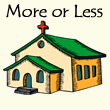From the Deacon J mailbox
BH from St. Petersburg, FL writes (excerpted):
Recently you invited us to send in our questions. Before doing so, I have to say I LOVE the Geranium Farm and I enjoy the writings of all of the contributors!
My husband and I have enjoyed the Sun. eve. CAYA (Come As You Are) service and the Sat. 5 p.m. Rite I service. Some time ago in a different city I attended a morning service and I know it is more formal.
Now to my question. In about the mid point of the service everyone makes the sign of the cross, they may say Thanks Be To God at that point too, my memory fails me on that. We have a program that we follow along with (very helpful for newbies) but I don't see that mentioned. Can you tell me at what point in the service this occurs?
I cannot find a mid-point during a Rite I service where those words would be said by the congregation. It is a common pious practise, however.... at the end of the Nicene Creed to make the sign of the cross at some point during the recitation of the final phrase "..resurrection of the dead and the life of the world to come". Two other specific moments when this sign is used are: 1) during the words of absolution (by the priest or bishop) and 2) after the words of institution in the Eucharist and before the Our Father, the sign of the cross is typically made during the section of the Eucharistic prayer when we 'offer ourselves' in dedication to Christ. The last sign of the cross is typically done during the dismissal blessing by the priest or bishop.
I still do not kneel before entering the pew, although within myself I am respectful. Is this okay?
Yes, this is fine. It is always important to bear in mind that - contrary to outward appearances - the corporate worship we participate in is for the glory of God. Period. While we each have our own style, the main objective is to dedicate the time you spend, the effort you spend, the attention you spend.... all for the glory of God. Some people genuflect (bend down on one knee), others pause at the entrance of the pew and respectfully bow the head (or bow at the waist), some make the sign of the cross. All of these gestures are simply signs of respect - the kind of respect that is afforded only royalty on formal occasions these days. Then again, aren't we coming before the King of Kings and Lord of Lords?
Do you think that pants for women are okay on Sun. a.m. I don't mean cutoffs and jeans with holes! The church I had been attending was quite relaxed in the dress code, shorts and pants were fine, but I do not want to feel out of place if dresses or skirts are the norm. Living in Florida it seems we are a bit more relaxed everywhere.
Here is another instance of local customary: your style and those you worship with. "When in Rome....." Yes, slacks are fine. This is a matter of personal piety and intention. If you are intentionally attending a parish that has a formal style of liturgy, odds are the dress code will be suits for men and dresses, skirts or nice suits for women: you'll know it right away. If, on the other hand, it is Parish "Clean Up" or "Picnic" Sunday where everyone is invited to attend the service, rake leaves or participate in a water balloon toss and then have hot dogs, it seems over the top to wear the high pumps and chiffon. In a standard 'formal' Sunday settings, the rule of thumb is: be neat, clean. To honor God some folks do - and always will - put on their 'Sunday best'. Appropriate dress is appropriate for the place you go and your function once you get there.
- - - - - - - -
From another reader (and the e-mail has evaporated into cyberspace, sorry!!!! so I will have to paraphrase) there were 2 things:
1) Since both priests and deacons have the same course of study, what is the difference between the two? Does a deacon officiate at a Eucharist?
According to specific guidelines for ordination, priests and deacons must fulfill study and show competancy in all canonical areas before being ordained. However, exactly how one fulfills those requirements can differ from diocese to diocese. Many a diocese requires that both priests and deacons attend a seminary and pass GOE's; others have their own specific School for Deacons or a diocesan training program.
In the most simple terms, a priest's function is to administer the sacraments and teach. A deacon's function is to gather and distribute. Now this gets a bit confusing when a priest comes along with the charism to lift up leadership in the laity or to run a soup kitchen -- or when a deacon is a gifted preacher and healer. Somehow the Church universal seems to function anyway! In technical terms, a deacon does not preside at services; they are not ordained with the ability to consecrate elements or pronounce absolution in the name of the church. They may distribute communion which has already been consecrated by a bishop or priest, but only in unusual circumstances may that happen at the principal service during the week (i.e. on Sunday).
2) How DO you address a bishop? You may address them verbally simply as "Bishop" or "Your Excellency", for an archbishop, "Your Grace" is sometimes used. In written terms, address for a Bishop is: The Right Reverend (Rt.Rev.) X X. If a doctorate is involved: The Rt. Rev. Dr. X X.
I hope this little explanation space has helped. Thanks for the questions - - keep them coming!














0 Comments:
Post a Comment
<< Home